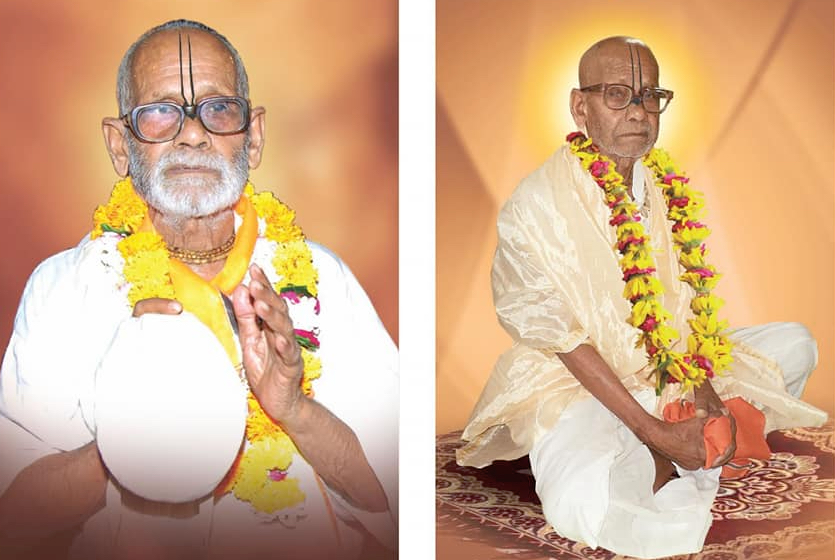Mahanidhi Madan Gopal Das
When Sri Sri 108 Pandit Sri Krishna Das Babaji Maharaja, Bhakti-tirtha was about 15 years old, three desires (sankalpas) mysteriously arose in his mind: “I will worship Radha-Krishna in the mood of gopi-bhava,” “I will study Srimad Bhagavatam!” “And I will chant Harinama and do Sankirtana!”
As a tender teen, Babaji Maharaja had no idea what is gopi-bhava. Nor did he know that the rest of long life of 101 years would be spent realizing these three desires. From where did these three beautiful, transcendental sankalpas come from? Bhagavan Sri Krishna answers in Sri Gita (6.44): purva abhyasena tenaiva, hriyate hy avaso pi sah, “Because of performing bhakti yoga sadhana in a prior life, one is automatically attracted to the same practices in this life.”
In 1918 (Magha Sukla Trayodashi), Babaji Maharaja appeared in Dakshina Khanda, West Bengal near the village of Gaura-Govinda nitya-parisada Sri Narahari Sarkar Thakura. Babaji Maharaja appeared in wealthy Brahmin family of Krishna bhaktas hailing from the Kasyapa and Shandilya gotras. At the age of five, Babaji Maharaja lost his mother and was raised by his grandparents.
In 1940, Babaji Maharaja graduated with honors from high school, and then stayed home managing the family estate. Most of the day, he chanted Sri Sri Radha-Krishna Nama (aka Hare Krishna maha-mantra).
Babaji Maharaja recalls those days saying, “I felt so much bliss in my mind while chanting Hare Krishna that I lost all interest in material life. I decided that I will leave home, become a sadhu and live in a Himalayan cave doing bhajan like Dhruva and Prahlada Maharaja.”
“Detecting my mood of detachment, my uncle gave me a Gita to read, hoping that I would learn about duty, stay home, get married and so on. However, the Gita had the opposite effect and after reading it, especially 9.33, 18.65-66, I became even more determined to leave home and become a sadhu.”
“Then one night Radha-Krishna appeared in my dream. They looked very beautiful dancing together in a most exquisite and attractive way. I moved towards them, but then They vanished, leaving me with an intense thirst to see them again.”
A short time later, Babaji Maharaja’s uncle’s baby of two years old was visiting his home. He gazed at Baba and suddenly surprisingly said in a most distinct way, “Dada! I give you a blessing: Become a sadhu!” At first, Babaji Maharaja couldn’t believe his ears, but then he thought that Bhagavan Sri Krishna must be speaking through that baby’s mouth.
“Being a young Indian boy, however, I was afraid to leave home and I worried about getting food and shelter. Then Krishna appeared in a dream holding a club and said, ‘Don’t worry or fear. Just leave home and become a sadhu. If anyone tries to harm you, I will destroy them with this club!’”
Babaji Maharaja left home and went to Gaya for Visnu darsana, Ganga snana, then on to Haridvar where he arrived after a month of walking. Babaji Maharaja lived on the bank of Ganga under a tree, and in a garden house offered by a sympathetic devotee. Babaji Maharaja passed a few years in Haridvar staying in different places, chanting Hare Krishna and studying Bhagavad-gita.
Babaji Maharaja then came to Vrndavana Dhama in 1940 and did Vraja parikrama subsisting on madhukari before settling in Cakalesvara, Govardhana. There Babaji Maharaja met a niskincana sadhu who lived doing bhajan and madhukari.
Feeling the utmost respect and attraction to him, Babaji Maharaja took diksa from that Gaudiya Vaisnava saint named Sri Sri 108 Sanatana Das Babaji Maharaja, who was the favorite vesh disciple of the famous Govinda Kunda Siddha Baba 108 Sri Sri Manohara Das Babaji.
In 1941, Babaji Maharaja took sannyasa (babaji vesh) before Sri Raghnuatha Dasa Goswami’s Samadhi. Babaji Maharaja spent time with his guru in Radha Kunda and Govardhana studying sastra in the association of Sri Kunjabihari Das Babaji, Gaura-Gopala Dasji, Sri Dina Sarana Maharaja, Priyacharana Dasji Maharaja, Parameshvara Dasji Maharaja, and Sri Advaita Das Babaji Maharaja.
Babaji Maharaja studied Sanskrit for a few years in Vrndavana and received degrees in Sanskrit vyakarana, Vaisnava darsana tirtha and became a Bhagavata acarya. Returning to Govardhana Govinda Kunda, Babaji Maharaja did bhajan, and served his Guru and the other great Govardhana nivasi bhajananadi sadhus staying at Govinda Kunda.
Not only was Babaji Maharaja an amazing Pandita, a strict vairagi and a perfect gentle man, he was expert in cooking, book keeping and managing entire temples and ashrams. Appreciating Babaji Maharaja’s superb scholarship, honesty and impeccable behavior several Vrndavana temple trusts requested his service as mahanta.
For 35 years, Babaji Maharaja selflessly served as the Mahant of the Gwalior Mandir, Kusuma Sarovara; Mahant of Siddha Manohara Das’s temple in Govinda Kunda, and the Radha-Syamasundara Mandir in Prema Sarovara.
Of his 101 years as a sadhu sannyasi, Babaji Maharaja did Radha-Krishna bhajan in Vraja Mandala for 80 years. All his belongings fit into one shoulder bag. Babaji Maharaja never had a bank account, personal kutira or any land. He wandered here and there living a complete vairagi life—sometimes staying in Govinda Kunda, Radha Kunda, Kusuma Sarovara, Prema Sarovara and Varsana.
He initiated many devotees, wrote several books on Gaudiya Vaisnava tattva, sadhana and sadhya, and often went to Bengal, Assam and other places to discourse on the Srimad Bhagavatam, and preach suddha Radha-Krishna bhakti bhajan, and the prema dharma introduced by Sri Caitanya Mahaprabhu.
During his long life Babaji Maharaja freely taught Sanskrit and the secrets of the Srimad Bhagavatam to scores of eager brahmacaris and Babajis. As a service whenever Babaji Maharaja was requested by other Gurus like Sri Sri 108 Pandit Sri Ananta Dasji Maharaja, he would give sannyasa vesh (bheka) to their disciples.
Babaji Maharaja was a gentle, humble, unassuming sadhu with a fantastic memory of slokas from the Bhagavatam, Gita and other sastra. He deeply knew all the Gaudiya Vaisnava siddhantas, and he would compassionately share his vast wisdom with anyone seeking his shelter.
Babaji Maharaja constantly stressed the need to take complete shelter in Harinama; always be completely humble; never offend any Vaisnava; and always remember the nitya-lilas of Radha Govinda Yugala. Govinda-lilamrta and Sri Raghnuatha Dasa Goswami’s Stavavali were his constant companions.
Babaji Maharaja satisfied the thirst of all seekers who came for his darsana. He emanated friendly warmth, care, and oceans of wisdom. Babaji Maharaja treated everyone like his own, making sure each and every devotee was satisfied and comfortable. And most importantly before leaving his sublime association, everyone just had to take Krishna prasadam, which he often personally served with the utmost love.
On January 11, 2019, at 7.10 A.M. Srimati Radharani came to Babaji Maharaja’s kutira in Varsana, and said, “Hey Baba! Now come with Me. We have to go to Nandagrama to cook breakfast for Sri Nandanandana.”
And thus Babaji Maharaja’s incredibly long life of Harinama, Gopi-Bhava and Bhagavata came to a beautiful close. He fulfilled his three sankalpas, perfected his bhakti sadhana bhajan, and went to Goloka Vrndavana to blissfully serve His beloved Radha Govinda Yugala for time eternal!
108 Sri Sri Pandit Sri Krishna Das Babaji Maharaja, Bhakti-tirtha ki jai!
Jai Jai Sri Radhe! Jai Gurudeva! Jai Gurudeva! Jai Gurudeva!


